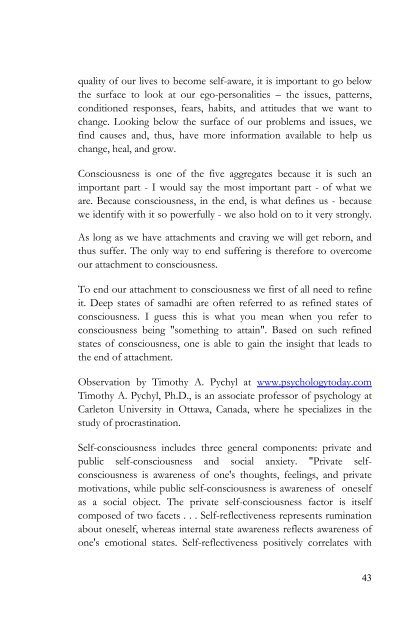Introduction to Mindfulness - Dean Amory
Art and Benefits of Mindfulness Meditation
Art and Benefits of Mindfulness Meditation
You also want an ePaper? Increase the reach of your titles
YUMPU automatically turns print PDFs into web optimized ePapers that Google loves.
quality of our lives <strong>to</strong> become self-aware, it is important <strong>to</strong> go below<br />
the surface <strong>to</strong> look at our ego-personalities – the issues, patterns,<br />
conditioned responses, fears, habits, and attitudes that we want <strong>to</strong><br />
change. Looking below the surface of our problems and issues, we<br />
find causes and, thus, have more information available <strong>to</strong> help us<br />
change, heal, and grow.<br />
Consciousness is one of the five aggregates because it is such an<br />
important part - I would say the most important part - of what we<br />
are. Because consciousness, in the end, is what defines us - because<br />
we identify with it so powerfully - we also hold on <strong>to</strong> it very strongly.<br />
As long as we have attachments and craving we will get reborn, and<br />
thus suffer. The only way <strong>to</strong> end suffering is therefore <strong>to</strong> overcome<br />
our attachment <strong>to</strong> consciousness.<br />
To end our attachment <strong>to</strong> consciousness we first of all need <strong>to</strong> refine<br />
it. Deep states of samadhi are often referred <strong>to</strong> as refined states of<br />
consciousness. I guess this is what you mean when you refer <strong>to</strong><br />
consciousness being "something <strong>to</strong> attain". Based on such refined<br />
states of consciousness, one is able <strong>to</strong> gain the insight that leads <strong>to</strong><br />
the end of attachment.<br />
Observation by Timothy A. Pychyl at www.psychology<strong>to</strong>day.com<br />
Timothy A. Pychyl, Ph.D., is an associate professor of psychology at<br />
Carle<strong>to</strong>n University in Ottawa, Canada, where he specializes in the<br />
study of procrastination.<br />
Self-consciousness includes three general components: private and<br />
public self-consciousness and social anxiety. "Private selfconsciousness<br />
is awareness of one's thoughts, feelings, and private<br />
motivations, while public self-consciousness is awareness of oneself<br />
as a social object. The private self-consciousness fac<strong>to</strong>r is itself<br />
composed of two facets . . . Self-reflectiveness represents rumination<br />
about oneself, whereas internal state awareness reflects awareness of<br />
one's emotional states. Self-reflectiveness positively correlates with<br />
43

















